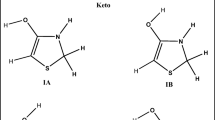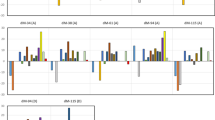Abstract
The electron donor ability of 37 melatonin (MLT) derivatives was investigated at the LC-ωPBE/6–311+G(d) level of theory, which was chosen based on a benchmark study using the experimental vertical ionization energy of MLT as the reference value. Twenty-three of these derivatives had been already synthesized, while 14 are proposed here for the first time. Those with better electron donor ability were identified using vertical ionization energies and the full electron donor acceptor map, both in aqueous solution. They are expected to have the best antioxidant activity provided that the main reaction mechanism ruling such activity is the electron transfer reaction from the MLT derivatives to free radicals. The drug-likeness of the studied compounds was analyzed using the Lipinski and Ghose rules, as well as the Veber criteria. Their synthetic availability and toxicity were also estimated. Considering the calculated data, altogether, two of the already synthesized compounds are proposed as the best prospects for being tested as oral drugs, with therapeutic uses as antioxidants. In addition, two of the derivatives designed here are proposed as the best candidates to be synthesized and tested for antioxidant activity, with potential to be used as oral drugs. These results might motivate the synthesis of these compounds; thus, their potential role as protectors against oxidative stress—and the associated health issues—could be experimentally tested.






Similar content being viewed by others
References
Tekiner-Gulbas B, Westwell AD, Suzen S (2013) Oxidative stress in carcinogenesis: new synthetic compounds with dual effects upon free radicals and cancer. Curr Med Chem 20(36):4451–4459
Matsuda M, Shimomura I (2014) Roles of adiponectin and oxidative stress in obesity-associated metabolic and cardiovascular diseases. Rev Endocr Metab Disord 15(1):1–10
Eren E, Ellidag HY, Cekin Y, Ayoglu RU, Sekercioglu AO, Yilmaz N (2014) Heart valve disease: the role of calcidiol deficiency, elevated parathyroid hormone levels and oxidative stress in mitral and aortic valve insufficiency. Redox Rep 19(1):34–39
Halliwell B (2001) Role of free radicals in the neurodegenerative diseases: therapeutic implications for antioxidant treatment. Drugs Aging 18(9):685–716
Pohanka M (2014) Alzheimer’s disease and oxidative stress: a review. Curr Med Chem 21(3):356–364
Pimentel C, Batista-Nascimento L, Rodrigues-Pousada C, Menezes RA (2012) Oxidative stress in Alzheimer’s and Parkinson’s diseases: insights from the yeast Saccharomyces cerevisiae. Oxid Med Cell Longev 2012:132146
Acuña-Castroviejo D, Escames G, Venegas C, Díaz-Casado ME, Lima-Cabello E, López LC, Rosales-Corral S, Tan DX, Reiter RJ (2014) Extrapineal melatonin: sources, regulation, and potential functions. Cell Mol Life Sci 71(16):2997–3025
Reiter RJ, Tan DX, Fuentes-Broto L (2010) Melatonin: a multi-tasking molecule. Prog Brain Res 181:127–151
Reiter RJ, Tan DX, Galano A (2014) Melatonin: exceeding expectations. Physiology (Bethesda) 29(5):325–333
Reiter RJ, Tan DX, Zhou Z, Cruz MHC, Fuentes-Broto L, Galano A (2015) Phytomelatonin: assisting plants to survive and thrive. Molecules 20(4):7396–7437
Ramis MR, Esteban S, Miralles A, Tan DX, Reiter RJ (2015) Protective effects of melatonin and mitochondria-targeted antioxidants against oxidative stress: a review. Curr Med Chem 22(22):2690–2711
Galano A, Tan DX, Reiter RJ (2011) Melatonin as a natural ally against oxidative stress: a physicochemical examination. J Pineal Res 51(1):1–16
Hardeland R (2005) Antioxidative protection by melatonin: multiplicity of mechanisms from radical detoxification to radical avoidance. Endocrine 27(2):119–130
Tan DX, Manchester LC, Terron MP, Flores LJ, Reiter RJ (2007) One molecule, many derivatives: a never-ending interaction of melatonin with reactive oxygen and nitrogen species? J Pineal Res 42(1):28–42
Jahnke G, Marr M, Myers C, Wilson R, Travlos G, Price C (1999) Maternal and developmental toxicity evaluation of melatonin administered orally to pregnant Sprague-Dawley rats. Toxicol Sci 50(2):271–279
Ceraulo L, Ferrugia M, Tesoriere L, Segreto S, Livrea MA, Turco Liveri V (1999) Interactions of melatonin with membrane models: portioning of melatonin in AOT and lecithin reversed micelles. J Pineal Res 26(2):108–112
Bonnefont-Rousselot D, Collin F (2010) Melatonin: action as antioxidant and potential applications in human disease and aging. Toxicology 278(1):55–67
Tan DX, Manchester LC, Reiter RJ, Qi WB, Karbownik M, Calvo JR (2000) Significance of melatonin in antioxidative defense system: reactions and products. Biol Signals Recept 9(3–4):137–159
Gurer-Orhan H, Suzen S (2015) Melatonin, its metabolites and its synthetic analogs as multi-faceted compounds: antioxidant, prooxidant and inhibitor of bioactivation reactions. Curr Med Chem 22(4):490–499
Galano A, Tan DX, Reiter RJ (2013) On the free radical scavenging activities of melatonin’s metabolite, AFMK and AMK. J Pineal Res 54(3):245–257
Reiter RJ, Tan DX, Jou MJ, Korkmaz A, Manchester LC, Paredes SD (2008) Biogenic amines in the reduction of oxidative stress: melatonin and its metabolites. Neuro Endocrinol Lett 29(4):391–398
Galano A, Medina ME, Tan DX, Reiter RJ (2015) Melatonin and its metabolites as copper chelating agents and their role in inhibiting oxidative stress: a physicochemical analysis. J Pineal Res 58(1):107–116
Álvarez-Diduk R, Galano A, Tan DX, Reiter RJ (2015) N-Acetylserotonin and 6-hydroxymelatonin against oxidative stress: implications for the overall protection exerted by melatonin. J Phys Chem B 119(27):8535–8543
Suzen S (2013) Melatonin and synthetic analogs as antioxidants. Curr Drug Del 10(1):71–75
Johns JR, Platts JA (2014) Theoretical insight into the antioxidant properties of melatonin and derivatives. Org Biomol Chem 12(39):7820–7827
Tsia PL, Hu MK (2003) Free radical scavenging and antioxidative activity of melatonin derivatives. J Pharm Pharmacol 55(12):1655–1660
Ates-Alagoz Z, Coban T, Buyukbingol E (2006) Synthesis and antioxidant activity of new tetrahydro-naphthalene-indole derivatives as retinoid and melatonin analogs. Arch Pharm 339(4):193–200
Ateş-Alagöz Z, Coban T, Suzen S (2005) A comparative study: evaluation of antioxidant activity of melatonin and some indole derivatives. Med Chem Res 14(3):169–179
Suzen S, Bozkaya P, Coban T, Nebioǧlu D (2006) Investigation of the in vitro antioxidant behaviour of some 2-phenylindole derivatives: discussion on possible antioxidant mechanisms and comparison with melatonin. J Enzyme Inhib Med Chem 21(4):405–411
Shirinzadeh H, Eren B, Gurer-Orhan H, Suzen S, Özden S (2010) Novel indole-based analogs of melatonin: synthesis and in vitro antioxidant activity studies. Molecules 15(4):2187–2202
Yilmaz AD, Coban T, Suzen S (2012) Synthesis and antioxidant activity evaluations of melatonin-based analogue indole-hydrazide/hydrazone derivatives. J Enzyme Inhib Med Chem 27(3):428–436
Gürkök G, Coban T, Suzen S (2009) Melatonin analogue new indole hydrazide/hydrazone derivatives with antioxidant behavior: synthesis and structure–activity relationships. J Enzyme Inhib Med Chem 24(2):506–515
Suzen S, Cihaner SS, Coban T (2012) Synthesis and comparison of antioxidant properties of indole-based melatonin analogue indole amino acid derivatives. Chem Biol Drug Des 79(1):76–83
Galano A (2016) Computational-aided design of melatonin analogues with outstanding multifunctional antioxidant capacity. RSC Adv 6(27):22951–22963
Frisch MJ, Trucks GW, Schlegel HB, Scuseria GE, Robb MA, Cheeseman JR, Scalmani G, Barone V, Mennucci B, Petersson GA, Nakatsuji H, Caricato M, Li X, Hratchian HP, Izmaylov AF, Bloino J, Zheng G, Sonnenberg JL, Hada M, Ehara M, Toyota K, Fukuda R, Hasegawa J, Ishida M, Nakajima T, Honda Y, Kitao O, Nakai H, Vreven T, Montgomery JA Jr, Peralta JE, Ogliaro F, Bearpark MJ, Heyd J, Brothers EN, Kudin KN, Staroverov VN, Kobayashi R, Normand J, Raghavachari K, Rendell AP, Burant JC, Iyengar SS, Tomasi J, Cossi M, Rega N, Millam NJ, Klene M, Knox JE, Cross JB, Bakken V, Adamo C, Jaramillo J, Gomperts R, Stratmann RE, Yazyev O, Austin AJ, Cammi R, Pomelli C, Ochterski JW, Martin RL, Morokuma K, Zakrzewski VG, Voth GA, Salvador P, Dannenberg JJ, Dapprich S, Daniels AD, Farkas Ö, Foresman JB, Ortiz JV, Cioslowski J, Fox DJ (2009) Gaussian 09. Gaussian Inc, Wallingford
Cannington PH, Ham NS (1983) He(I) and He(II) photoelectron spectra of glycine and related molecules. J Electron Spectrosc Relat Phenom 32(2):139–151
Marenich AV, Cramer CJ, Truhlar DG (2009) Universal solvation model based on solute electron density and on a continuum model of the solvent defined by the bulk dielectric constant and atomic surface tensions. J Phys Chem B 113(18):6378–6396
Martinez A, Vargas R, Galano A (2009) What is important to prevent oxidative stress? A theoretical study on electron-transfer reactions between carotenoids and free radicals. J Phys Chem B 113(35):12113–12120
Martínez A, Rodríguez-Girones MA, Barbosa A, Costas M (2008) Donator acceptor map for carotenoids, melatonin and vitamins. J Phys Chem A 112(38):9037–9042
Galano A (2007) Relative antioxidant efficiency of a large series of carotenoids in terms of one electron transfer reactions. J Phys Chem B 111(44):12898–12908
Boda K, Seidel T, Gasteiger J (2007) Structure and reaction based evaluation of synthetic accessibility. J Comput Aided Mol Des 21(6):311–325
Bonnet P (2012) Is chemical synthetic accessibility computationally predictable for drug and lead-like molecules? A comparative assessment between medicinal and computational chemists. Eur J Med Chem 54:679–689
Zhu H, Tropsha A, Fourches D, Varnek A, Papa E, Gramatical P, Öberg T, Dao P, Cherkasov A, Tetko IV (2008) Combinatorial QSAR modeling of chemical toxicants tested against Tetrahymena pyriformis. J Chem Inf Model 48(4):766–784
Galano A (2016) Computational-aided design of melatonin analogues with outstanding multifunctional antioxidant capacity. RSC Adv 6(27):22951–22963
Lipinski CA, Lombardo F, Dominy BW, Feeney PJ (2001) Experimental and computational approaches to estimate solubility and permeability in drug discovery and development settings. Adv Drug Del Rev 46(1–3):3–26
Ghose AK, Viswanadhan VN, Wendoloski JJ (1999) A knowledge-based approach in designing combinatorial or medicinal chemistry libraries for drug discovery. 1. A qualitative and quantitative characterization of known drug databases. J Comb Chem 1(1):55–68
Veber DF, Johnson SR, Cheng HY, Smith BR, Ward KW, Kopple KD (2002) Molecular properties that influence the oral bioavailability of drug candidates. J Med Chem 45(12):2615–2623
Leeson PD, Davis AM (2004) Time-related differences in the physical property profiles of oral drugs. J Med Chem 47(25):6338–6348
Acknowledgments
The author acknowledge the Laboratorio de Visualización y Cómputo Paralelo at Universidad Autónoma Metropolitana-Iztapalapa for computing time. This work was partially supported by project SEP-CONACyT 167491.
Author information
Authors and Affiliations
Corresponding author
Additional information
Published as part of the special collection of articles “Festschrift in honour of A. Vela”.
Rights and permissions
About this article
Cite this article
Galano, A. A first principles investigation on the electron donor ability of synthetic melatonin derivatives: implications for their antioxidant activity. Theor Chem Acc 135, 157 (2016). https://doi.org/10.1007/s00214-016-1917-6
Received:
Accepted:
Published:
DOI: https://doi.org/10.1007/s00214-016-1917-6




